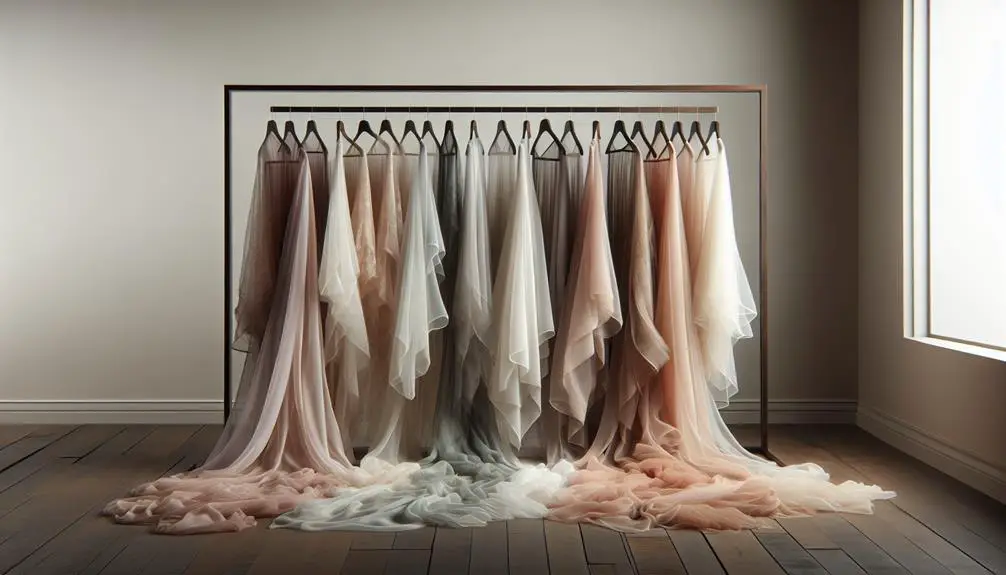Chiffon is a really soft and lightweight fabric, which gives it a sheer texture and a beautiful drape. It first came around in France, originally made from silk, which made it quite a luxury. Nowadays, you can find chiffon made from synthetic materials like polyester, nylon, and rayon too, which are more budget-friendly and easier to handle. While silk chiffon is all about that luxury feel and delicate touch, synthetic chiffon offers practicality and durability. Both types weave into stunning garments, especially for layered looks because their thinness adds a touch of lightness and elegance without bulking up. There's much more to uncover about its uses and variations!
Table of Contents
Key Takeaways
- Chiffon is a lightweight, sheer fabric known for its beautiful draping qualities.
- It is made from silk, polyester, or nylon through a weaving process that involves twisting the threads.
- The fabric is characterized by its slight transparency and elegant appearance, making it popular in evening wear and bridal gowns.
- Chiffon can be either silk, which is luxurious and soft, or synthetic, which offers durability and easier maintenance.
- Due to its delicate nature, chiffon requires special care in handling, including gentle washing and air drying.
History of Chiffon
Chiffon's journey began in France, where it was first crafted by weaving together fine threads of silk. The name 'chiffon' itself hints at the fabric's delicate and airy nature, derived from the French word for 'cloth' or 'rag'. This origin story isn't just a fun fact; it's a window into the luxurious past of chiffon, initially reserved for the elite due to its intricate manufacturing process and the high cost of silk.
By the 20th century, however, technological advancements had reshaped the textile industry. The introduction of synthetic fibers like nylon and polyester in the production of chiffon democratized its usage. No longer was chiffon exclusive to the aristocracy; it became accessible to the masses, integrating into everyday fashion as well as high couture. This shift not only changed who could wear chiffon but also expanded its uses beyond traditional garments like evening dresses and scarves to more casual and versatile applications.
Understanding this evolution helps in appreciating not just the fabric itself but also the broader socio-economic landscape it has woven through. Chiffon's story is a testament to how innovation can transform luxury into a common good, making beauty accessible to all.
Basic Characteristics
Let's talk about what makes chiffon so unique.
First off, it's incredibly lightweight and has a sheer texture that really stands out.
Plus, it drapes beautifully, flowing gracefully in whatever garment it's crafted into.
Lightweight Sheer Texture
Chiffon fabric often boasts a lightweight, sheer texture that gives it a delicate and airy feel. When I hold a piece up to the light, I can see right through it, which showcases its transparency. This sheer quality makes chiffon an excellent choice for overlays in garments or for adding a light touch to outfits without adding bulk.
It's also worth noting that due to its thinness, chiffon is incredibly light; it barely adds any weight when you wear it. This makes it perfect for those flowy, ethereal looks I love in summer dresses and scarves. Despite its delicate appearance, it's surprisingly strong, thanks to the way it's made, typically from silk or synthetic fibers like polyester.
Flowing Drape Quality
Building on its sheer texture, chiffon also stands out for its ability to drape elegantly, flowing smoothly over any silhouette. This quality makes it a favorite for evening wear and bridal gowns. It's just the right fabric if you're aiming for a graceful, airy look.
Here's a simple breakdown of chiffon's drape characteristics:
| Feature | Description | Benefit |
|---|---|---|
| Lightness | Extremely lightweight | Enhances flow and movement |
| Transparency | Slightly see-through | Adds subtlety to layers |
| Texture | Soft with a slight roughness | Provides a natural, fluid shape |
Understanding these aspects helps you appreciate why chiffon is so cherished in fashion design. It's all about creating pieces that look effortlessly elegant.
Types of Chiffon Fabrics
Now, let's talk about the different types of chiffon fabrics you can find.
Silk chiffon varieties are known for their luxury and soft texture, while synthetic chiffon options are more affordable and durable.
Each type has its own unique qualities that make it suitable for various fashion needs.
Silk Chiffon Varieties
Among the different types of chiffon, silk chiffon is prized for its luxurious feel and elegant appearance. This variety is made from silk, a natural protein fiber, which gives it an incredibly smooth texture that's a delight against the skin. Silk chiffon is notably lightweight and has a slight sheen that enhances its beauty, making it a favorite for formal garments like evening dresses and wedding gowns.
It's important to know that silk chiffon can vary in weight and transparency, affecting how it drapes and flows. Typically, the lighter the chiffon, the more delicate and sheer it appears. Handling silk chiffon requires care, as its fine threads can be prone to snagging and fraying. Mastery of sewing with this fabric ensures elegant, floaty creations.
Synthetic Chiffon Options
While silk chiffon's elegance is undeniable, synthetic chiffon varieties offer affordability and durability. If you're looking for options that are easy on the wallet and can withstand regular wear and tear, you'll find synthetic chiffon to be a practical choice. It's made from man-made fibers like polyester, nylon, or rayon, which are not only cheaper but also maintain their color and shape over time.
Here's a quick breakdown of the most common types of synthetic chiffon:
| Type | Characteristics | Best for |
|---|---|---|
| Polyester | Resistant to shrinking, fading | Daily wear |
| Nylon | Lightweight, strong | Active wear |
| Rayon | Soft, breathable | Evening wear |
Each type brings something special to the table. Choose based on your specific needs!
How Chiffon Is Made
Chiffon is typically made by weaving together fine threads of silk, polyester, or nylon. The process starts with these threads being tightly twisted, which gives chiffon its slight puckering nature that you can see and feel. This puckering allows chiffon to somewhat resemble the texture of fine mesh when looked at closely.
The weaving itself is done using a plain weave technique. This means each weft thread (the thread that runs horizontally) alternates over and under the warp threads (the threads that run vertically), creating a simple criss-cross pattern. It's this method that makes the fabric both lightweight and durable.
To ensure the fabric is of high quality, I'm careful about the tension used during weaving. Too tight, and the fabric loses its gentle drape; too loose, and it becomes weak and unusable. After weaving, the fabric is often treated to achieve a desired finish or texture. This could include processes like dying to add color or chemical treatments to enhance durability.
Comparing Silk and Synthetic Chiffon
Let's explore how silk chiffon differs from its synthetic counterparts. Silk chiffon, derived from silkworms, boasts a superior elegance and natural sheen that synthetic versions, made from materials like polyester, can't quite match. The feel of silk chiffon is unmistakably smoother and more luxurious, setting it apart in terms of touch and overall quality.
Here are key differences to consider:
- Texture and Feel: Silk chiffon is softer and drapes more naturally than synthetic chiffon, which can feel slightly coarse by comparison.
- Durability and Care: Silk chiffon is delicate and requires gentle handling, typically needing dry cleaning. Synthetic chiffon, however, is more resilient and often machine washable, making it easier to maintain.
- Environmental Impact: Producing silk chiffon is more resource-intensive, demanding significant labor and ecological footprint. Synthetic chiffon, while less labor-intensive, involves non-renewable resources, contributing to environmental concerns.
Both types of chiffon have their unique advantages, but it's the context of use and personal preference that will guide your choice. Whether you lean towards the natural elegance of silk or the practical resilience of synthetic materials, understanding these differences helps in making informed decisions.
Popular Uses in Fashion
Designers often favor chiffon for its ability to add elegance and flow to various garments. It's a go-to choice for evening wear and wedding dresses, primarily due to its ethereal quality that beautifully captures and diffuses light. I've noticed that chiffon isn't just limited to formal wear; it's also popular in more casual settings. Think breezy summer dresses or elegant blouses that you can wear to both a day out or an office meeting.
Chiffon's lightweight nature makes it perfect for layered styles, adding depth without the bulk. Scarves and wraps made from chiffon are particularly popular because they offer warmth without heaviness, making them ideal for transitional weather. Additionally, its slight transparency allows for playful layering options in fashion design, where it can be used over or under other fabrics to create interesting visual effects.
Moreover, designers love to use chiffon for flowing skirts and sleeves that flutter with movement. The fabric's airiness brings a dynamic element to the runway, where the movement of the material itself can be a show-stopper. It's these qualities that make chiffon a staple in the fashion industry, celebrated for its versatility and timeless appeal.
Chiffon in Home Décor
While typically associated with fashion, chiffon also finds a charming place in home décor, adding a touch of softness and elegance to any room. I've personally found that its sheer texture and breezy feel can transform a space without overwhelming it. It's light, airy, and you can use it in various creative ways to enhance your living environment.
Here's how I incorporate chiffon into my home décor:
- Window Treatments: Chiffon curtains are perfect for letting in natural light while offering a bit of privacy. They flutter beautifully with the slightest breeze, creating a tranquil and soothing atmosphere.
- Canopy Over Beds: Draping chiffon over a bed gives a luxurious and romantic vibe to the bedroom. It's like turning your sleeping area into a serene retreat.
- Table Decorations: Using chiffon as a table runner or placemats during special occasions adds a festive and elegant touch. It's great for dinner parties or family gatherings.
Each of these uses highlights chiffon's versatility beyond just clothing. It's about blending functionality with style. By choosing the right color and texture, chiffon can complement nearly any décor theme, from modern minimalist to classic vintage. It's more than just fabric; it's a way to express your personal style in your home.
Caring for Chiffon
Taking care of chiffon isn't as daunting as it might sound. I'll walk you through how to wash it properly, dry it safely, and share some handy tips for ironing chiffon without damage.
It's all about the right techniques to keep your chiffon looking flawless.
Washing Chiffon Properly
To keep your chiffon looking its best, it's crucial to wash it correctly. Chiffon can be tricky, so I use gentle methods to avoid damaging this delicate fabric. Here's how I do it:
- Use Cold Water: Hot water can cause chiffon to shrink, so I always stick to cold water to keep the fabric in top shape.
- Gentle Detergent: I opt for a mild detergent that's designed for delicate fabrics. Harsh chemicals can ruin chiffon's texture.
- Hand Wash: To avoid snags and tears, I hand wash my chiffon garments. It's a bit more effort, but it definitely extends their life.
Following these steps helps me maintain the beauty and longevity of my chiffon pieces.
Drying Chiffon Safely
After washing, drying chiffon the right way is crucial to keep it looking its best. You'll want to avoid wringing it out to prevent damage. Instead, gently squeeze out excess water or let it drip dry. Using a drying rack or laying it flat on a towel works wonders. Here's a quick guide:
| Method | Tip |
|---|---|
| Air Drying | Hang or lay flat, avoid direct sunlight |
| Towel Drying | Roll chiffon in a towel to absorb moisture |
| Drying Rack | Spread evenly, reshape if necessary |
| Avoid Heat | Skip the dryer, high heat can cause shrinkage |
| Gentle Handling | Don't wring out, gently squeeze water out |
Ironing Tips for Chiffon
Ironing chiffon requires a gentle touch and the right technique to avoid damage. I've learned a few tricks to make sure my chiffon pieces look great without risking harm. Here's what you should keep in mind:
- Low Heat Setting: Always set your iron to the lowest heat. Chiffon can burn or melt easily.
- Pressing Cloth: Use a light cotton pressing cloth between the iron and the chiffon to protect delicate fibers.
- No Steam: Avoid using steam which can leave watermarks or cause shrinkage.
Common Challenges With Chiffon
Working with chiffon can be tricky due to its slippery texture and delicate nature. I've found that it easily shifts and slides under your fingers, making precision cuts and seams a real challenge. When you're trying to line up the edges or keep your stitching straight, the fabric can seem like it has a mind of its own!
Another issue I constantly face with chiffon is its tendency to fray. This fraying can quickly get out of hand, especially if you're handling the edges more than necessary. It's like watching your hard work unravel, literally, which can be pretty frustrating when you're aiming for a clean, finished product.
Chiffon's transparency also poses a unique challenge. Choosing the right color and type of thread is crucial because every stitch shows. You can't hide mistakes as easily as you might with more opaque fabrics. This means every little slip-up is visible, demanding a higher level of precision and care during sewing.
And let's not forget about the static! Chiffon loves to cling to itself and anything else it can, including tools, other fabrics, and even your hands. This can make handling and laying out your project more complicated than you might expect.
Tips for Sewing With Chiffon
So, how do you sew with chiffon without all the hassle? I've learned a few tricks along the way that make a world of difference. First up, it's all about the right setup. Let me break it down for you.
Chiffon is notoriously slippery, so handling it can be quite a challenge. Here's what's worked for me:
- Use the right needles and thread: Grab a fine, sharp needle—think size 70/10. A fine polyester thread will do the trick since it's strong but doesn't bulk up the seams.
- Stabilize the fabric: To keep the chiffon from shifting under your sewing machine, use tissue paper or a wash-away stabilizer beneath the fabric while sewing. This little hack keeps everything in place, and you can easily tear away the paper or rinse out the stabilizer later.
- Practice patience and gentle handling: Chiffon can fray and snag easily. Always handle it gently, and give yourself plenty of time. Rushing through your sewing project with chiffon? That's a recipe for frustration.
Stick to these pointers, and you'll find that sewing with chiffon becomes much less daunting. It's about taking those extra steps to ensure a smooth sewing experience.
Future Trends in Chiffon Usage
Looking ahead, chiffon is set to revolutionize the fashion industry with its adaptability and evolving uses. I'm seeing it pop up everywhere, from high fashion runways to everyday streetwear. The fabric's lightness and semi-transparency offer endless possibilities for layering and texture, making it a favorite among designers looking to push boundaries.
I expect we'll see more innovations in how chiffon is used, particularly in blending it with other materials. Imagine chiffon with embedded electronics that light up under certain conditions or chiffon mixed with recycled fibers to promote sustainability in fashion. These aren't just ideas; they're on the verge of becoming real.
Moreover, as digital printing technology advances, custom printed chiffon is becoming more accessible. This means smaller designers can experiment without the need for large scale production. It's a game changer for bespoke fashion and consumers looking for something truly unique.
Lastly, the push towards more ethical fashion practices will likely influence how chiffon is produced. We might see a shift towards organic silk chiffons or the development of completely synthetic options that mimic the properties of silk chiffon without the environmental footprint.
Chiffon's future is as exciting as it's versatile. I'm here for it, and you should be too!
Frequently Asked Questions
Can Chiffon Be Dyed at Home, and How?
Yes, I've dyed chiffon at home using acid dyes for silk versions or fabric dye for synthetic ones. Just follow the instructions carefully, especially the temperature and soaking time for best results.
Is Chiffon Fabric Suitable for Winter Clothing?
I wouldn't recommend chiffon for winter clothing because it's lightweight and doesn't provide much warmth. It's better suited for summer outfits where breathability and a light drape are more desirable.
How Does Chiffon React to Perspiration?
Chiffon doesn't handle sweat well; it can show sweat stains and might cling uncomfortably. It's not the best for activities where you'll break a sweat, as it lacks moisture-wicking properties.
What Are Eco-Friendly Alternatives to Traditional Chiffon?
I'm exploring eco-friendly alternatives to traditional chiffon, like bamboo or recycled polyester. They're sustainable, reduce waste, and still offer that light, airy feel we all love in our flowy dresses and scarves.
Can Chiffon Be Used for Activewear Designs?
I wouldn't recommend chiffon for activewear; it's too delicate and lacks the necessary stretch. You'd be better off with fabrics designed for movement and durability like spandex or nylon blends.
- Where to Buy Sherpa Suede Fabric - July 12, 2025
- How to Draw or Illustrate the Texture of Suede Fabric - July 12, 2025
- What Is Baseball Suede Leather Fabric? - July 12, 2025





